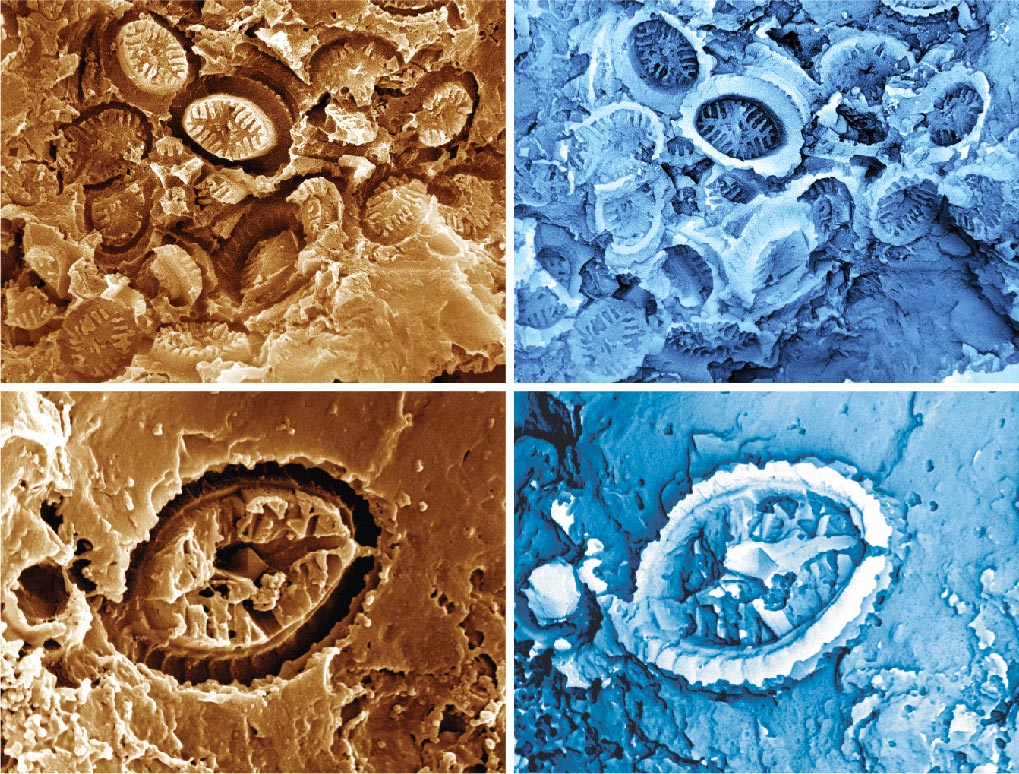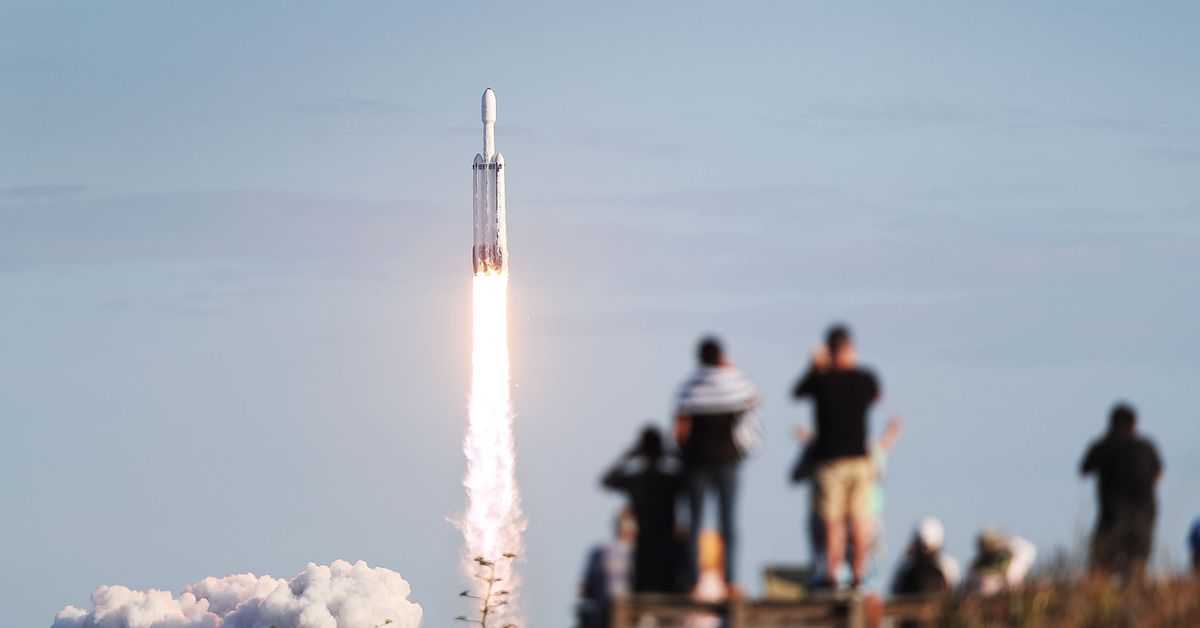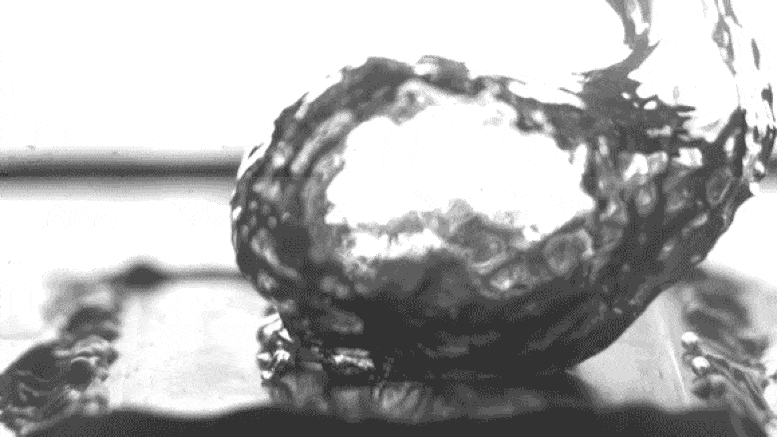
이미지는 서브 미크론 규모 구조의 현저한 보존을 보여주기 위해 개별 판(시럽)을 확대한 고대 유기물 조각(왼쪽)의 표면에 있는 붕괴된 세포벽 덮개(cocosphere)의 인상을 보여줍니다(오른쪽). 파란색 이미지를 반전시켜 가상의 화석 이미지, 즉 원래의 3D 모양을 보여줍니다. 원래의 석판은 용해에 의해 퇴적물에서 제거되어 유령의 흔적만 남았습니다. 크레딧: S.M. Slater, P. Bowen/Science Journal
국제 연구팀이 새로운 유형의 화석을 발견했습니다.
‘유령’ 화석의 발견은 과거의 지구 온난화 사건에 직면한 플랑크톤의 회복력을 보여줍니다.
UCL(University College London), 스웨덴 자연사 박물관(Swedish Museum of Natural History), 런던 자연사 박물관(Natural History Museum), 플로렌스 대학(University of Florence)의 과학자들로 구성된 국제 팀은 지금까지 거의 눈에 띄지 않는 놀라운 유형의 화석을 발견했습니다.
화석은 수백만 년 전에 바다에 살았던 coccolithophores라고 불리는 단세포 플랑크톤의 미세한 지문 또는 “유령”이며, 그들의 발견은 기후 변화가 바다의 플랑크톤에 어떻게 영향을 미치는지에 대한 우리의 이해에 혁명을 일으켰습니다.
Coccolithophores는 오늘날의 바다에서 중요하며 우리가 호흡하는 많은 산소를 제공하고 해양 먹이 사슬을 지원하며 해저 퇴적물에 탄소를 가둡니다. 그들은 암석에서 일반적으로 분해되는 coccoliths라고 불리는 단단한 석회암 판으로 세포를 둘러싸고 있는 일종의 미세한 플랑크톤입니다.
이 화석의 풍부함의 감소는 지구 온난화 이전의 여러 사건으로부터 문서화되었으며, 이는 이 플랑크톤이 기후 변화와 해양 산성화에 의해 심각한 영향을 받았음을 나타냅니다. 그러나 오늘 저널에 한 연구가 발표되었습니다. 과학 풍부한 유령화석 3종으로 세계 신기록 제시[{” attribute=””>Jurassic and Cretaceous warming events (94, 120, and 183 million years ago), suggesting that coccolithophores were more resilient to past climate change than was previously thought.

The individual plates are coccoliths. Credit: Images from Nannotax https://www.mikrotax.org/Nannotax3/
“The discovery of these beautiful ghost fossils was completely unexpected,” says Dr. Sam Slater from the Swedish Museum of Natural History. “We initially found them preserved on the surfaces of fossilized pollen, and it quickly became apparent that they were abundant during intervals where normal coccolithophore fossils were rare or absent – this was a total surprise!”
Despite their microscopic size, coccolithophores can be hugely abundant in the present ocean, being visible from space as cloud-like blooms. After death, their calcareous exoskeletons sink to the seafloor, accumulating in vast numbers, and forming rocks such as chalk.

The fossils are approximately 5 µm in length, 15 times narrower than the width of a human hair. Credit: S.M. Slater, P. Bown et al. / Science journal
“The preservation of these ghost nannofossils is truly remarkable,” says Professor Paul Bown (UCL). “The ghost fossils are extremely small ‒ their length is approximately five-thousandths of a millimeter, 15 times narrower than the width of a human hair! ‒ but the detail of the original plates is still perfectly visible, pressed into the surfaces of ancient organic matter, even though the plates themselves have dissolved away.”
The ghost fossils formed while the sediments at the seafloor were being buried and turned into rock. As more mud was gradually deposited on top, the resulting pressure squashed the coccolith plates and other organic remains together, and the hard coccoliths were pressed into the surfaces of pollen, spores, and other soft organic matter. Later, acidic waters within spaces in the rock dissolved away the coccoliths, leaving behind just their impressions – the ghosts.

Ghost nannofossils were found in rocks from global warming intervals where normal coccolithophore fossils were rare or absent. Credit: S.M. Slater, P. Bown, et al. / Science journal
“Normally, paleontologists only search for the fossil coccoliths themselves, and if they don’t find any then they often assume that these ancient plankton communities collapsed,” explains Professor Vivi Vajda (Swedish Museum of Natural History). “These ghost fossils show us that sometimes the fossil record plays tricks on us and there are other ways that these calcareous nannoplankton may be preserved, which need to be taken into account when trying to understand responses to past climate change.”
Professor Silvia Danise (University of Florence) says: “Ghost nannofossils are likely common in the fossil record, but they have been overlooked due to their tiny size and cryptic mode of preservation. We think that this peculiar type of fossilization will be useful in the future, particularly when studying geological intervals where the original coccoliths are missing from the fossil record.”

Ghost nannofossils were found globally, in rocks from three rapid warming events in Earth’s history (the T-OAE, OAE1a, and OAE2). Credit: S.M. Slater et al.
The study focused on the Toarcian Oceanic Anoxic Event (T-OAE), an interval of rapid global warming in the Early Jurassic (183 million years ago), caused by an increase in CO2-levels in the atmosphere from massive volcanism in the Southern Hemisphere. The researchers found ghost nannofossils associated with the T-OAE from the UK, Germany, Japan, and New Zealand, but also from two similar global warming events in the Cretaceous: Oceanic Anoxic Event 1a (120 million years ago) from Sweden, and Oceanic Anoxic Event 2 (94 million years ago) from Italy.
“The ghost fossils show that nannoplankton were abundant, diverse, and thriving during past warming events in the Jurassic and Cretaceous, where previous records have assumed that plankton collapsed due to ocean acidification,” explains Professor Richard Twitchett (Natural History Museum, London). “These fossils are rewriting our understanding of how the calcareous nannoplankton respond to warming events.”
Finally, Dr. Sam Slater explains: “Our study shows that algal plankton were abundant during these past warming events and contributed to the expansion of marine dead zones, where seafloor oxygen-levels were too low for most species to survive. These conditions, with plankton blooms and dead zones, may become more widespread across our globally warming oceans.”
Reference: “Global record of “ghost” nannofossils reveals plankton resilience to high CO2 and warming” by Sam M. Slater, Paul Bown, Richard J. Twitchett, Silvia Danise and Vivi Vajda, 19 May 2022, Science.
DOI: 10.1126/science.abm7330

“요은 베이컨과 알코올에 대한 전문 지식을 가진 닌자입니다. 그의 탐험적인 성격은 다양한 경험을 통해 대중 문화에 대한 깊은 애정과 지식을 얻게 해주었습니다. 그는 자랑스러운 탐험가로서, 새로운 문화와 경험을 적극적으로 탐구하며, 대중 문화에 대한 그의 열정은 그의 작품 속에서도 느낄 수 있습니다.”










